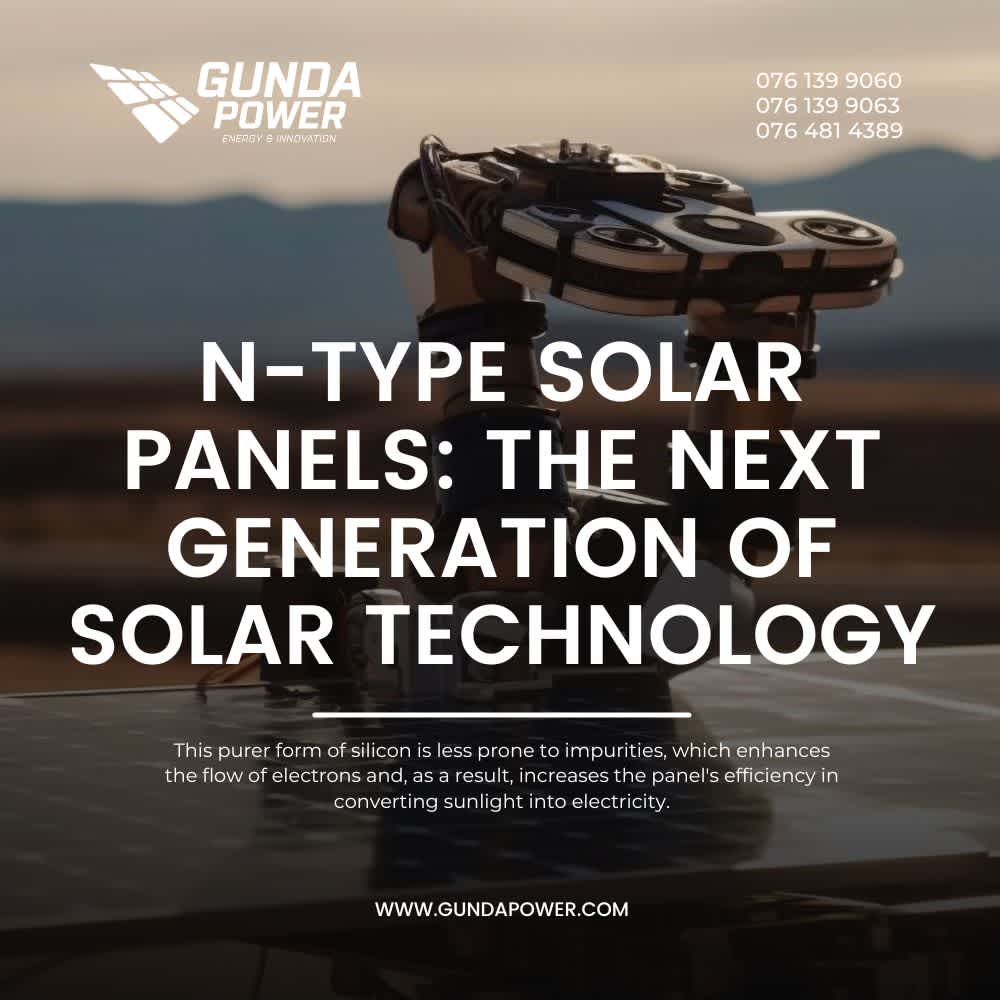N-Type Solar Panels: The Next Generation of Solar Technology
19 August 2024 by Nuwan Goonewardena
6 min read

N-Type Solar Panels: The Next Generation of Solar Technology
N-Type solar panels represent an advancement in solar cell technology, distinguishing themselves from the more widely used P-Type solar cells by using N-Type silicon as the base material. This purer form of silicon is less prone to impurities, which enhances the flow of electrons and, as a result, increases the panel's efficiency in converting sunlight into electricity.
How Are N-Type Solar Panels Made?
The key to N-Type panels lies in their sophisticated manufacturing process. They begin with a thin silicon wafer, similar to that used in P-Type panels, but with an added step. The silicon wafer is treated with phosphorus gas to create the N-Type layer, while boron is used to form the P-Type layer. This dual-layer design significantly boosts the cell's performance. Although N-Type panels are more expensive to produce, their superior performance and longevity make them a cost-effective investment in the long run.
Why Opt for N-Type Solar Panels?
N-Type solar panels have a storied history, with the first solar cell created by Bell Labs in 1954 being an N-Type. Recently reintroduced for commercial use, these panels are more efficient and durable than traditional solar panels. Made with a different type of silicon, N-Type panels can absorb more sunlight, resulting in higher electricity generation.
One of the standout features of N-Type solar panels is their resistance to light-induced degradation (LID), a common issue that causes traditional solar panels to lose efficiency over time. This makes N-Type panels a better long-term investment, particularly in regions like Australia where high-efficiency and durability are crucial.
The Advantages of N-Type Solar Panels
Higher Efficiency: N-Type panels can produce up to 20% more electricity compared to traditional panels.
Improved Temperature Tolerance: They perform better in high temperatures, making them ideal for hot climates.
Longer Lifespan: With an expected lifespan of up to 30 years, N-Type panels outlast traditional solar panels.
Reduced LID Susceptibility: N-Type panels are less affected by light-induced degradation, maintaining their efficiency over time.
Fewer Defects: These panels are less prone to impurities and defects, leading to more consistent performance.
Higher Power Output: N-Type panels typically offer power ratings much higher than many traditional panels.
Given these benefits, N-Type solar panels are an excellent choice for those seeking high-quality and long-lasting solar solutions.
N-Type vs. P-Type Solar Panels: A Detailed Comparison
Both N-Type and P-Type solar panels are made of silicon, but their performance varies due to differences in their manufacturing processes.
The Future of Solar Panels: N-Type Leading the Way
While P-Type solar panels remain common, N-Type panels are gaining ground, with projections suggesting they could capture 28% of the market by 2028, according to ITRPV. As the solar industry continues to evolve, N-Type solar panels represent a promising leap forward in technology and efficiency.
Keep Reading...

Recent economic analysis confirms that renewable energy sources—particularly solar and wind—remain the most cost-effective options for new electricity generation in the United States

Across the United States, commercial and industrial (C&I) businesses are evolving their approach to on-site energy infrastructure. Many organizations that previously invested in solar installations are discovering new opportunities.

As energy resilience becomes increasingly critical, these localized energy systems are emerging as key solutions for both businesses and consumers.

Thank you for choosing Gunda Power, your one stop shop for all your solar equipment needs. We are dedicated to providing top-quality solar products under one roof.
Quick Links
News & Articles
- New Cooling Hydrogel Could Boost Solar Panel Efficiency by 12%
- Renewable Energy Maintains Cost Advantage in US Energy Market Despite Low Gas Prices
- Transforming Commercial Solar Assets into Profitable Microgrids
- Unlocking a More Affordable, Reliable Future with Solar Microgrids
